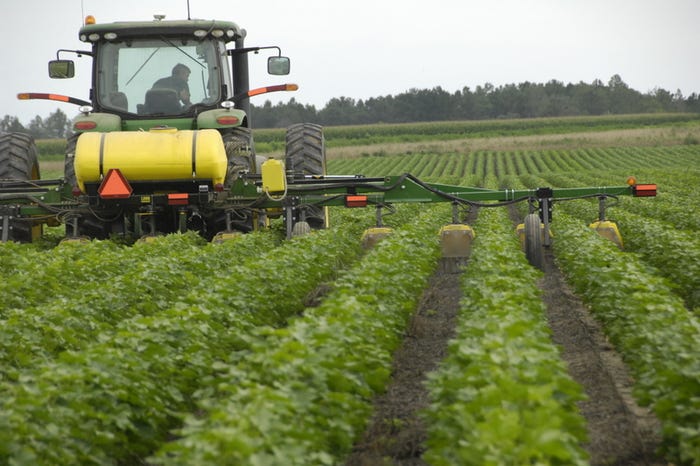
Pigweed resistant to post-emergence PPO has been in Georgia for a couple of years. Researchers have confirmed the pigweed population is also resistant to the residual activity of PPO herbicides in greenhouse studies.
(EDITOR’S NOTE: PPO resistance is a growing concern across the Delta and Southeast. This is part two of a two-part series which looks at PPO-resistance in Georgia cotton systems. This installment explains science-backed recommendations to help growers stay ahead of this weed management problem.)
Start off weed free. “There are a lot of ways to be pigweed free at planting, and growers know how to make it happen, but that doesn't mean the environment or equipment will cooperate to make it happen,” said Stanley Culpepper, University of Georgia Extension weed specialist. His team confirmed the PPO resistance in Georgia.
Weed-free at planting begins with a good herbicide program coupled with tillage or a cover crop. If a grower hasn’t deep turned a field in five years, it could be beneficial if erosion isn’t an issue, he said.
Culpepper prefers conservation tillage, though. “The data shows Palmer Amaranth is not a very happy plant growing in conservation tillage,” he said.
In studies in Georgia and Tennessee, a good cover crop, such as rye, can reduce the number of pigweed plants per acre that will need to be handled with a post-emergence applications. With conventional tillage, the number of pigweed plants by POST can be as high as 872,000 plants per acre. A rye cover can knock that population back 65%, or to 300,000 plants per acre.
Cover can bring better odds with fewer plants come POST time, “but that 300,000 plants can still eat your lunch. Cover crops alone are not sustainable for us,” he said. “You must implement them in a sound, integrated diversified management program. The most important method of controlling Palmer Amaranth is using two residual herbicides at planting. It is the single largest thing that you will do to impact the management of this plant species within the crop season.”
Good options for at-plant residuals include Brake, Cotoran, Direx, Prowl, Reflex, Treflan and Warrant.
“Combinations can be effective depending on your soil type and the pest you're trying to manage, and in this case pigweed,” he said.
The only combination he doesn’t recommend is Prowl and Reflex as a tank mix and applied preemergence. “When I apply those two products together preemergence, I get an excessive amount of Prowl damage. It only occurs in a combination with Reflex, and it happens about 50% of the time in our research,” he said. “There is no question soil type and production method influence this event.”
Post-emergence applications, as growers know, must be timely. “How timely probably depends on the residuals and how the residuals were applied at planting,” he said. “Growers make the first post-emergence application, and then need to plan on a sequential application. Remember, pigweed is not controlled very effectively with Dicamba, 2,4-D or Liberty if it has any size at all. Sequential applications make the program successful.”
Culpepper continued to urge cotton growers to bring back the ol’ layby, or hooded, application. Though nearly extinct, its value isn’t.
Layby
If a grower is seeing more morningglory, spiderwort, more pigweed or grasses, whether in a dicamba, Liberty or 2,4-D system, data suggests a layby application is needed, he said.
“Over-the-top applications early in the season do a fantastic job of covering weeds and getting residual herbicides to the ground. But later in the year, we may just be covering the cotton with the herbicide, which may cause damage to the crop,” he said. “Yet it doesn't provide the opportunity to put the herbicide where it needs to go. And that's covering the weeds hiding under the cotton as well as getting the residual herbicides to the ground under the cotton.”

Credit: Rome Ethredge, UGA Extension.
The layby application allows opportunity to use good herbicide tools “to annihilate pretty much any weed that's up, assuming you're timely, and it provides excellent residual weed control for three to four weeks into that crop, letting it close out.”
He said if a grower continues to just apply over the top, in three to four years a bad equilibrium will settle across a field. Those four weed species will become so problematic, the grower will have to make drastic changes on the farm to shift the balance.
“Or a grower can make the change now and run the layby rig in that 10% or 20% of the farm where these weeds are becoming more problematic. This approach will be one of the most economically sustainable decisions a grower can make based on our science,” he said.
(Not-so-fun fact to remember, Georgia’s cotton industry has invested more than $2 billion to manage glyphosate-resistant pigweed since the discover of the world’s first case of glyphosate resistance in a pigweed in the state two decades ago.)
About the Author(s)
You May Also Like






